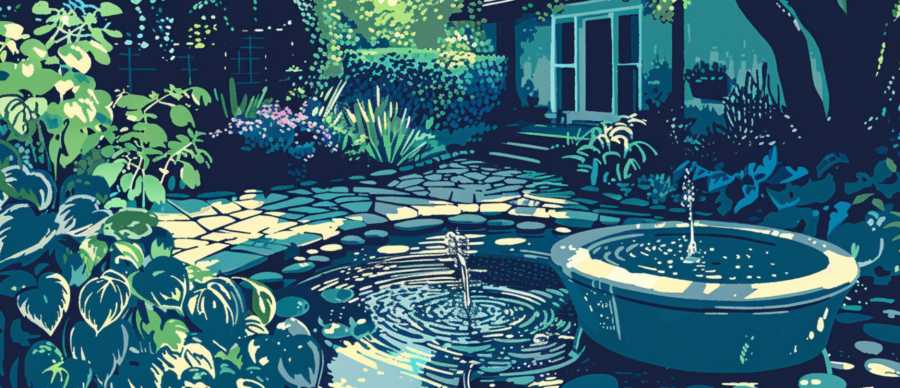Reading the Light
Before buying hardware, map the sun. Note where it climbs, where it stalls, and where it drops behind chimneys or trees. A simple method: sit outside on the hour for a day and sketch the shadow edges. It’s lo-fi, gloriously unscientific, and surprisingly revealing. You’ll discover that the hottest spot isn’t always the brightest one, and that your favorite chair is perfectly placed for… thirty-seven minutes per day.Serious note: light has direction, intensity, and color temperature. East light is cool and revealing, noon light is vertical and unforgiving, and evening light leans warm and horizontal, throwing long, dramatic lines. Your structures should respond to those facts, not fight them.
Pergolas as Precision Tools
A pergola is not just a rectangle on legs; it’s a **dial**. Slat spacing, slat angle, and height decide how much light you admit and when. Narrow spacing gives soft, even shade; wider spacing yields bold bands that move like a slow shutter across the table. Tilt slats toward the south to blunt summer sun, and keep them flatter if your winters are gray and you crave every lumen.Materials matter. Pale timber reflects light upward, brightening faces. Dark metal eats glare while radiating heat more quickly at night. If you plan climbers, leave room for airflow so humidity doesn’t turn into mildew auditions. Anchoring is non-negotiable: treat wind like a recurring character, not a cameo.
Awnings that Actually Think
Retractable awnings are your mood switches. Fixed fabric gives steadfast shade; retractable arms let you modulate by hour. Think projection depth: too shallow and high-angle sun slips under like a mischievous cat; too deep and your interior goes gloomy. If you’re near water or glassy neighbors, choose low-gloss fabrics to tame mirror-bounce. Patterns? Subtle stripes can visually stretch a small terrace, but large motifs may strobe under wind—thrilling for five minutes, tiring forever.For a quick sanity check when choosing:
- Match fabric density to sun intensity; heavyweight weaves for brutal noon, lighter weaves for soft mornings.
- Confirm the drop angle clears doors and doesn’t guillotine tall friends.
- Measure runoff paths so rain doesn’t leap from the awning’s edge into your collar.
Screens that Edit Reality
Screens don’t just block; they **edit**. Vertical slats temper low sun without killing cross-breezes. Fine mesh turns harsh light into a calm, even wash, ideal for reading or laptop work. Laser-cut panels cast crisp lacework at noon and blur to soft geometry by dusk—visual interest without the interrogations of direct glare. Position screens to intercept the angles you dislike most rather than building a fortress around the entire patio.Rhythm and Restraint
Light wants to move; your job is to give it rhythm. Don’t aim for uniform shade—there’s no poetry in consistency. Alternate open and closed zones so your eyes, and body, can rest. Picture a midday lunch beneath half-shadow: the air stirs, the salad doesn’t wilt, and the person opposite you doesn’t squint like they’re interrogating the menu. Light through slats should feel accidental, not mathematical, yet every “accident” takes planning.Here’s where restraint comes in. Too many overlapping systems—awnings, pergolas, screens, parasols, vines—can create visual clutter and psychological confusion. You’re building calm, not an obstacle course. Limit the number of moving parts so shadows can breathe and patterns have space to register.
Dappled is a Design Language
Dappled light is nature’s soft focus. It flatters people, textures, and glassware alike. Recreating it artificially means layering materials that scatter and diffuse—perforated metal, woven reed, tensile cloth. Each one edits light differently: metal yields crisp geometry, reed bends it into gauze, cloth blurs edges like an analog filter. Combine two and you get motion; as wind or sun angle shifts, the patterns animate your surfaces.But dappled light also conceals dirt magnificently, which is both blessing and trap. Clean occasionally; otherwise, your tranquil scene will gain the patina of a forgotten greenhouse.
When Form Meets Function (and Neighbors)
Every garden structure performs double duty: shaping light and screening life. A slatted wall that manages glare also becomes the boundary between your espresso and their leaf blower. Choose dimensions that block sight lines without feeling defensive. High enough for privacy, low enough to invite breeze. Think of it as diplomatic architecture: it whispers “we coexist” rather than “keep out.”If you share fences, discuss your plans—sunlight disputes make poor winter reading. Position structures so they don’t rob adjacent plots of light, or you’ll find your beautiful pergola starring in next spring’s complaint letter.
Maintenance: The Quiet Negotiation
Wood silvers, metal warms, fabrics fade. Light is a relentless interrogator of surfaces. Accept that patina is part of the equation, but ensure it’s elegant decline, not chaotic decay. Annual sanding and oiling, periodic bolt checks—small rituals that keep the play of light intentional rather than tragic. If your structure creaks ominously in wind, that’s not character; that’s physics reminding you it exists.Sometimes the most luxurious garden moment is not buying something new, but re-tightening what you already have.
Shade Happens
The reward for all this is subtle: a space that changes mood by the hour, where morning coffee tastes bright and evening wine feels theatrical. Shade is not an absence—it’s the sculptor of perception. When you design for light, you’re really designing for time, mood, and the patience to watch things drift from gold to grey.And yes, there’s pleasure in the absurd precision of it—angling slats by degrees, trimming vines for shadow density. But once you’ve done it, you’ll sit beneath that lattice of shifting lines and feel—without a word—that the sun is playing along.
Article kindly provided by gardenhearth.co.uk/furniture-structures


